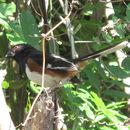Comprehensive Description
provided by Smithsonian Contributions to Zoology
Pipilo erythrophthalmus (Linnaeus)
In the last general survey of the brown-headed cowbird's hosts (Friedmann, 1963:150–151), it was noted that few instances of parasitism on this towhee had been reported from California, but that the recent spread and increase of the parasite in the southern parts of that state would probably result in further records. Three such instances have come to light: 1, collected in San Luis Obispo County, 2 June 1934, is now in the Santa Barbara Museum of Natural History, and 2 more—1 from near Mendota, Fresno County, 1 June 1935, and 1 from near Stockton, 21 June 1942—are in the collections of the Western Foundation. The San Luis Obispo record involves the host subspecies P. erythrophthalmus megalonyx; the other 2 have to do with the race P. erythrophthalmus falcinellus. The last mentioned subspecies is new to the host catalog of the parasite.
The Western Foundation's collections contain 393 sets of eggs of this towhee (all races), 11 of which (2.8 percent) are parasitized. A list of only those races of the host known to be victimized by the cowbird, yields the following data: P. erythrophthalmus erythrophthalmus, 55 sets, 9 (16.3 percent) parasitized; P. erythrophthalmus falcinellus, 8 sets, 2 (25.0 percent) parasitized; P. erythrophthalmus canaster, 3 sets, none parasitized; P. erythrophthalmus arcticus, 7 sets, none parasitized; P. erythrophthalmus montanus, 14 sets, none parasitized; P. erythrophthalmus curtatus, 1 set, not parasitized; P. erythrophthalmus oreganus, 37 sets, none parasitized; P. erythrophthalmus falcifer, 57 sets, none parasitized; and P. erythrophthalmus megalonyx, 173 sets, none parasitized.
The Ontario nest records files at Toronto have data on 70 nests, 14 of which (20.0 percent) were parasitized.
BROWN TOWHEE
- bibliographic citation
- Friedmann, Herbert, Kiff, Lloyd F., and Rothstein, Stephen I. 1977. "A further contribution of knowledge of the host relations of the parasitic cowbirds." Smithsonian Contributions to Zoology. 1-75. https://doi.org/10.5479/si.00810282.235

